Ozone and UVR trends from 1998 to 2005 at Diekirch (L)

|
Ozone and UVR trends from 1998 to 2005 at Diekirch (L)
|
|
Francis Massen
Meteorological Station of the Lycée Classique de Diekirch,
Luxembourg (http://meteo.lcd.lu)
Nico Harpes
Radiation Protection Office, Ministry of Health, Luxembourg (http://www.drp.etat.lu)
Hugo De Backer, RMI, Royal
Meteorological Institute, Belgium (http://www.meteo.be)
version 1.1 04 July 2006
O3_UVB_trends.html
Abstract:
This paper computes and analyses the trends in ground ozone, total ozone column and UV radiation as measured by meteoLCD from 1998 to 2005. Both mean ground ozone and yearly peak ground ozone concentrations show a negative trend. On the contrary total ozone column shows a positive trend of 1.7 DU/year, with no obvious change in the dates of the extremes. All trends in solar radiation doses are positive, the relative trend of eff. UVB dose being smaller than the corresponding UVA trend; increasing sunshine duration seems the most probable factor, as the mean eff. UVB irradiance has nearly no trend when the heat wave year 2003 is discarded. The period 1998-2005 covers the major part of only one single sun-cycle (#23); this time is much too short to extrapolate into the future.
This version 1.1. should not be considered as the definitive answer to O3 and UVR trends at Diekirch; the paper will be edited/augmented in future releases, which will be clearly stated.
Index:
| 1. | Data and Equipment |
| 2. | Table of results |
| 3. | Trend in Ground ozone |
| 4. | Trend in total ozone column |
| 5. | Trend in effective UVB , UVA and TSI |
| 6. | Addendum A: abbreviations and units used |
| 7. | References |
| 8. | Acknowledgments |
The meteorological station of the Lycée Classique de Diekirch (meteoLCD, http://meteo.lcd.lu)
measures ozone and UVR since it's start in 1996; it is a semi-rural station,
installed on top of a building ca. 25m above ground level; the town of Diekirch
has a population of about 5000 and no heavy industries. The only nearby
industrial building is the Diekirch brewery ("Brasserie de Diekirch")
located upwind at about 200m. No influence from the working of
this brewery on the air-quality measurements of meteoLCD has been found.
This paper is restricted to
the period 1998-2005, which has a good record with relative few instrument problems or
breakdowns. All data used are available at the data archive of meteoLCD.[1]
Ground ozone was measured by two different instruments, both using the
absorption of a specific wavelength emitted by an Hg lamp to compute the ozone
concentration. From 1998 to 15th Dec. 2003 the O3M41 from Environnement SA was
used (see [2] for details); starting 16 Dec. 2003 a new instrument M100E from
Teledyne API measured ground ozone [3] . Erythemal UVB radiation as well as UVA
were measured by temperature stabilized Solar Light Biometers, and total solar
irradiance (TSI) by a Kipp & Zonen CM21 ventilated pyranometer . All these
measurements are done in an automated way, at a rate of 1 minute; the mean of
30 minutes is stored in the databases found at the data archive. Total ozone
column is measured by a handheld Microtops II Sunphotometer, also from Solar
Light. Two different models of this instruments were used during the period:
Serial 3012 from 1998 to 1st May 2003 and serial 5375 from 2nd May 2003 to
1995. A comparison [7] of these ozone column measurements with those done with
a Brewer at Uccle and with two satellites shows that the first instrument
readings should be multiplied by 0.95, and the second either not at all (2003)
or by 0.95 (2004 presumed, 2005 verified) to give measurements equal to those of a Brewer. In this
paper, all total column data are the raw meteoLCD readings multiplied by 0.95,
except for 2003 where no multiplier is needed.
The UVB radiation will be given as a yearly dose in kWh/m2 and as a mean MED/h
effective irradiance. 1 MED is taken as 250 J/m2 effective UVB dose. UVA
and TSI will be given in W/m2 or as a yearly dose in kWh/m2. All radiation
readings were done with horizontal sensors. For ozone
concentration the European conventional unit of ug/m3 is used; 1 ppbV = 2.14 ug/m3 ~ 2
ug/m3.
Fig 1. contains the data used in this paper; the heat-wave year 2003 data are in red; column 13 contains the "raw" total ozone column measurements.

Table 1. Summary of measurement data
To distinguish a rising or falling UVB irradiance, we use the variable UVB_by_UVA = (1000*UVB_dose)/(UVA_dose); this allows to decouple the UVB from the TSI. In a similar way, we may use NO2_by_NO = (Mean_NO2)/(Mean_NO) to detect an eventual trend in one of these two gases.
Table 2 gives the % of availability of the different parameters; the question if the mean values should be multiplied by 100/(%availability) to uniformize the results remains unanswered, as the influence of missing data has a seasonal dependence; by a strict criterion, only UVB readings where the temperature of the thermally stabilized sensor was between [24..26°C] should be considered; this explains the lower %availability of the UVB readings versus the number of the readings actually made. All UVB (and UVA) readings given in the paper do satisfy this condition.
| Year | Ground O3 availability |
eff. UVB %availability |
TSI %vailability |
Air temp %availability |
| 1998 | 98.23 | 97.02 | 98.23 | 98.22 |
| 1999 | 91.4 | 75.65 | 98.09 | 91.41 |
| 2000 | 84.67 | 84.10 | 96.45 | 97.26 |
| 2001 | 99.41 | 98.34 | 100.00 | 99.41 |
| 2002 | 94.63 | 93.01 | 100.00 | 99.82 |
| 2003 | 100.00 | 99.97 | 100.00 | 100.00 |
| 2004 | 98.18 |
100.00 |
98.70 | 100.00 |
| 2005 | 96.17 | 99.99 | 100.00 | 100.00 |
Table 2. Availability of the different sensors in % of total time of the year
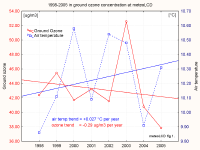 fig.1 |
Fig.1 shows the trend over the 8 years 1998-2005, together with the mean
temperature measured by an electronic thermometer protected by a radiation
shield. It should be noted that the equipment was moved the 16th Dec. 2003 for about 30m from its
original placement in a container on the flat roof of the building (at about 20m
over ground-level and 210 m asl) to its definitive location in a good insulated brick
construction also on the roof (25m above ground level, 215m asl). This graph is
not adjusted for the different availabilities. The data show (not surprisingly) a small positive temperature gradient, but contrary to public belief, a very small negative trend for ground ozone of about -0.30 ug/m3 per year ( -0.15 ppb/year). This should be compared to the findings of the EMEP/CCC-1/2005 report "The development of European surface ozone" [4], where the overall background concentration of ground ozone is increasing at most (but not all) measurement stations, the medium values do not show any trend and the ozone peaks are decreasing. |
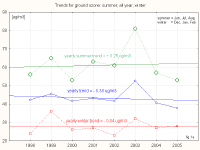 fig.1a |
Fig 1a compares yearly and seasonal trends. The
winter trend is flat, the summer trend gives an increase of 0.25 ug/m3 par
year; this positive trend is essentially caused by the exceptional
heat-wave summer 2003. If this summer is discarded, the summer trend
becomes negative: -0.61 ug/m3 per year. The winter mean concentrations correspond to the background ozone level, which is 28 +/- 4.3 ug/m3 (mean +/- standard deviation); Diekirch does not show an increasing ozone background, opposite to what the EMEP report says for the majority of European stations. As the positive summer trend is caused by one single exceptional summer, one should conclude that all mean ground ozone concentrations either are stable, or have a small negative trend.. Even an exceptional warm summer does not modify this situation in a dramatic manner, when the heat-wave is not too frequent ( for instance more than once per 8 years). |
The absolute peak concentrations at meteoLCD are given in table 3 and the trend in fig. 2
The heat-wave year 2003 stands out with a maximum peak concentration of 234 ug/m3 (which is the mean of 30 measurements done from 11:30 to 11:59 UTC); but even this exceptional high concentration does not imprint a positive trend. Similar to the EMEP report, the peak concentrations are decreasing over the 8 year period.
Let us compute the total mass of ozone that a standard human would have inhaled during a year. A respiratory rate of 10 inspirations per minute and a inhalation volume of 0.5 liter will be assumed; this gives 150 liter air inhaled during half an hour. Multiplying by 10-9*[O3] gives the total mass of O3 in gramm inhaled during 30 minutes. So the yearly inhaled ozone mass in g can be computed by
![]()
where [O3] is the half-hour mean concentration measured in ug/m3 and stored in the data file. Table 4 gives these results. To adjust for missing readings, the computed totals have been multiplied by 100/(availability on %); it should be noted that the assumptions for the inhaled volume per breathing is very low, so that this mass represents a minimum for an adult person.
| Year |
Yearly inhaled Ozone mass [g] (adjusted) |
| 1998 | 0.111 |
| 1999 | 0.119 |
| 2000 | 0.110 |
| 2001 | 0.114 |
| 2002 | 0.109 |
| 2003 | 0.138 |
| 2004 | 0.107 |
| 2005 | 0.100 |
Table 4: Approximate total ozone mass inhaled during one year
As the computed ozone mass is proportional to the yearly mean, the negative %trend is
equal to that given in fig.1
Ground ozone is primarely caused by UVB radiation acting on precursor gases like
NO2 and VOC's; most NO2 comes from fossil fuel burning and traffic exhaust, but
an important part of the VOC's (for instance terpenes) have a natural origin: coniferous
trees for example may release important quantities of these gases ( up to 7
kg*km-2*h-1), sometimes 5-6 times greater than anthropogenic
emissions [10, 11]). A principal
problem in finding a relationship between ground ozone and UVB measured by a ground
station is that higher concentrations of ozone filter out some part of the UVB
irradiance; so there should be a "natural" negative correlation
between [O3] and UVB under similar sky conditions (same cloudiness, same solar
zenithal angle or same air mass, as shown in [6]).
We will analyze the relationship between the mean yearly ground ozone
concentration, total solar dose [kWh/m2], effective UVB dose [kWh/m2] and UVA/UVB
[no unit] using the unadjusted data. The NO2 concentrations are always very low
with the exception of a morning traffic spike, and do not seem to vary much
during the year.
| Year | ground ozone [ug/m3] | eff. UVB dose [kWh/m2] | 1000*UVB/UVA | Total Solar dose [kWh/m2] |
| 1998 | 42.39 | 0.109 | 2.46 | 1111 |
| 1999 | 45.46 | 0.142 | 2.47 | 1076 |
| 2000 | 41.71 | 0.117 | 2.44 | 1048 |
| 2001 | 43.23 | 0.133 | 2.39 | 1049 |
| 2002 | 41.57 | 0.135 | 2.45 | 1073 |
| 2003 | 52.56 | 0.147 | 2.41 | 1250 |
| 2004 | 40.78 | 0.130 | 2.43 | 1108 |
| 2005 | 37.86 | 0.135 | 2.35 | 1122 |
| correlation with mean ground ozone | 0.49 | 0.26 | 0.70 | |
Table 5: mean ground ozone and solar light
The correlation between mean ground ozone concentration and total solar dose is the highest; it is not significant at the 5% level but it is at the 6% level. The correlation between ground ozone and UVB measured at the top of the troposphere surely would be highly positive and much better than the calculated 0.49, which includes the positive role of UVB in the generation of O3 (without UVB no O3) and the negative due to the "missing" UVB at ground level caused by O3 generation in the atmosphere. The UVB/UVA fraction does not seem to be an adequate predictor.
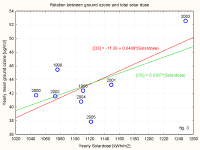 fig.3 |
Fig.3 shows the positive influence of Total Solar Dose at ground level, and implied, of total UVB dose at the top of the troposphere, on yearly mean ground ozone. A linear fit forced through the origin gives [O3] = 0.0387 * Solardose, with [O3] in ug/m3 and Solardose in kWh/m2. Thus the usual yearly solar dose of 1100 kWh/m2 on a horizontal plane would give a mean ground ozone concentration of about 43 ug/m3 at Diekirch. |
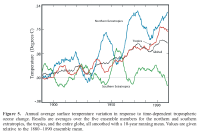 fig.3a |
A recent paper by Shindell et al.[14] shows that climate models simulating the increase of ground ozone levels since pre-industrial times give an enhanced ozone-induced summer-warming of ~0.5°C over polluted northern continental regions. Thus ground ozone levels are worth measuring, not only for their potential risks on health, plant-life and plant-yields, but also as possible contributors to a warmer climate. Fig. 3a gives the ozone-induced warming as suggested by the climate models. |
Conclusion: Ground ozone concentrations are not increasing at Diekirch: despite a perceptible ongoing warming, the mean and the peak concentrations show a negative trend. This is contrary to the positive correlation between temperature and ozone which exists usually at a small time-scale ( i.e. time scale of a day), as shown by fig.4

fig.4: daily variations of ground ozone and temperature at meteoLCD station
4. Trend in Total Ozone Column
Total ozone column is measured by a Microtops II sun photometer, manufactured by Solar Light Co. These measurements are not automated, but done by hand if weather conditions permit. The measurements of meteoLCD are regularly checked against those made by the RMI at Uccle (near Brussels, about 130km distance, 120m asl.); the resulting calibration factors are given in table 6, and the complete intercomparison can be found at [7]. Figure 5 shows that the trend is positive: +1.7 DU/year.
Table 6: total ozone column in [DU], as measured by meteoLCD
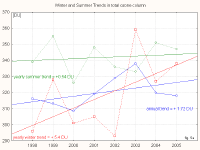 fig.5a |
All seasonal data show positive trends, as given by fig. 5a which compares annual, winter (DJF) and summer (JJA) trends. It should be noted that the winter trend is especially strong: +5.4 DU/year versus 0.54 DU/year for the summer! There is some debate if an arctic ozone hole will appear in the next future due to increased ozone depleting PSC (polar stratospheric clouds), and extend eventually to mid-European latitudes; for the moment at least the data at Diekirch give no indication of a thinning of the ozone layer, but on the contrary show an increasing thickness. |
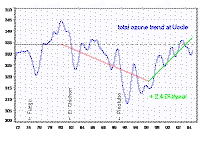 fig.6 |
The trend found at Diekirch can be compared to the RMI situation at at Uccle: + 2.4 DU/year. Fig.6 gives the measurements of Uccle for the period 1972 to 2004 [5]: the graph clearly shows a "recovery" from the initial negative trend, starting in 1997. Is this a consequence of the Montreal protocol (1987 and 1992) which started the compulsory phasing out of ozone depleting substances (see variation of chlorine ozone depleting gases in [12]) , is the trend part of a "natural" cycle or are both causes active [15] ? |
Table 7 gives the extreme values and the amplitude between the annual extreme events, and fig.7 shows that the maxima remain practically stable and the minima have a slight positive trend.
| Year | maximum | date of max. | minimum | date of min. | amplitude | |
| 1998 | 445 | 12-Apr | 225 | 18-Feb | 220 | |
| 1999 | 437 | 10-Feb | 236 | 2-Dec | 201 | |
| 2000 | 429 | 27-Mar | 209 | 29-Nov | 220 | |
| 2001 | 438 | 22-Apr | 221 | 08-Dec | 217 | |
| 2002 | 435 | 28-Feb | 259 | 11-Nov | 176 | |
| 2003 | 491 | 30-Jan | 226 | 25-Nov | 265 | |
| 2004 | 420 | 23-Mar | 238 | 25-Nov | 182 | |
| 2005 | 432 | 24-Jan | 237 | 17-Nov | 195 |
It should be noted that the highest of the peak columns happened in the
heat-wave year 2003, but at a moment (30-Jan) very distant from the onset of
that event. A causal relationship between these two extreme events seems
difficult to imagine... Most maxima fall in the time-span between end of January
and mid-April; neglecting the minimum outlier from 1998, all lows happen very
close during a 3 week period from 11 November to 8 December. No time-shift
neither for maxima nor minima is visible.
Many of the extreme readings given here do not appear in the intercomparison
paper [7], because in this paper only measurements
done at nearly the same moment at Diekirch and Uccle were retained for the
analysis, thus leaving out many of the data points from Diekirch (and
Uccle too).
Conclusion: Total ozone column is increasing since 1998; this situation is similar to that found at Uccle.
5. Trend in doses of effective UVB , UVA and TSI
We will use the energy doses in kWh/m2 of effective UVB, UVA and TSI do make our analysis. The correlation table shows that the doses of UVB and UVA are extremely well correlated, but surprisingly bad to the solardose. The correlation between UVB_dose and total ozone column (dobson_cal) is positive, and not negative as one could have expected from the filtering action of the ozone layer. A glance at the temporal evolution gives a better insight (fig.8)

Table 8
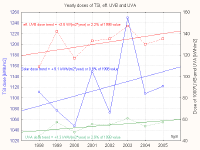 fig.8 |
All three doses have a positive trend: TSI dose
increases by 0.8%/year corresponding to base value 1998, both eff. UVB and
UVA have positive trends of similar magnitude: +2.1%/year for UVB and +2.9
%/year for UVA, all relative to 1998 values. The positive trend of the total ozone column may be
responsible for a larger filtering of the UVB, what would explain the
slightly smaller trend compared to that of UVA, which is not effected by
ozone absorption. The big differences in % trends between the TSI and UV doses could mean that the sun is continuing its evolution to a more active state [8], with a greater %-increase in UV emissions than in TSI. This more active sun creates a greater quantity of stratospheric ozone, which exceeds the lowering of the ground ozone levels found at Diekirch.. This makes a positive correlation between TSI dose and total ozone column understandable. |
 fig.8d |
Fig 8d shows the trends in mean eff. UVB
irradiance, for the full year and for winter (DJF) and summer (JJA)
seasons. The winter trend is virtually flat, whereas the yearly and summer months have a
positive yearly trend of about +4 mMED/h or 2.2% of the 1998 value; it
should be noted that omitting the heat-wave year 2003 changes this trend
to nearly zero. Whereas the UVR doses are directly influenced by sunshine duration, the mean UVB irradiance is not. The data show that indeed shunshine duration is on a continuing increase since 1998. The mean UVA irradiance increase is ~1.5 kWh/m2 or + 3.4% of the 1998 value, with or without taking the year 2003 into account. |
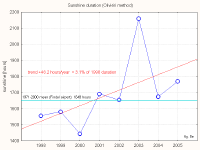 fig.8e |
Sunshine duration is not directly measured by a
specific meteoLCD instrument; we will compute this duration by using an
empirical formula established by Jean Oliviéri from Meteo France
(personal communication [13]). This method
works in the following way: 1. Compute Gmod = computed ground-level irradiance ( simplified model): Gmod = 1080*(sin(h))^1.25 [W/m2], h = solar elevation angle = 90 -Zs 2. If TSI > Gmod*F and the zenithal angle Zs<87°, the sun shines; F is an experimental factor depending on the location of the station and defined as: F = 0.73+0.06*sin(2*PI*d/365), where d = day of the year (d = 1..365) Here again we have a positive trend (about +48 hours/year or 3.1% of
the 1998 value); this trend
remains positive even if the years 1998-2000 (lower availability) and 2003
(heat-wave) are discarded.
|
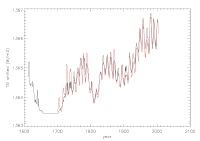 fig.9 |
For the record, here is the trend in TSI as given in the technical note 62 from the Hadley Centre [8]; there is a strong ongoing increase since 1900. |
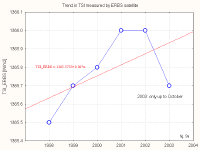 fig.9a |
A better picture can be obtained by the data from the ERBS satellite, which are available up to October 2003 on the NOAA ftp site [9]; figure 9a shows a strong positive trend of 0.13 (W/m2)/year for the years 1998 to 2002 ( or 0.06 if the year 2003 is included); as these years represent the rising part of one sun-spot cycle, this trend does not come as a surprise. |
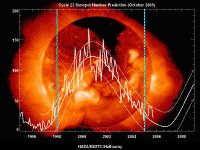 fig.10 |
The period 1998-2005 is centered on and covers the major (~75%) part of sunspot cycle #23, including equally both the rising and falling parts, as shown in fig.10; even if this centered position eliminates much of the influence of the periodical changes in solar radiation, it is much too short to compute reliable future trends of climate relevant parameters driven by the activity of the sun. |
Conclusion: All solar radiation doses are increasing at Diekirch; the lower increase of eff. UVB versus UVA is compatible with the positive trend found in total ozone column. As the period of this paper extends over only 75% of one solar-cycle, one should be warned from extending the trends found into the future!
Table with abbreviations used:
| ug/m3 | micro-gram per cubic meter = 10-6 g/m3 = 10-9 kg/m3 = concentration unit |
| ppbV (often: ppb) | parts per billion Volume = 10 -9 = mixing ratio (no unit). 1 ppbV O3 ~ 2.14 ug/m3 at standard conditions |
| ppmV (often: ppm) | parts per million Volume = 10 -6 = mixing ratio (no unit) |
| effective UVB | UVB irradiance (or dose) with the CIE action spectrum being applied to respect the large differences in skin sensitivity regarding UVB wave-length |
| MED | Minimal Erythemal Dose = effective UVB energy unit = 250 effective J/m2 in this paper. 1 MED is the minimal dose to get a sunburn (phototype II skin) |
| MED/h | Minimal Erythemal dose per hour = effective UVB power ( or irradiance) unit = 0.069 eff. Watt |
| Biometer | Eff. UVB and UVA sensors built by Solar Light Co. |
| EMEP | Co-operative Programme for Monitoring and Evaluation of the Long-Range Transmission of Air Pollutants in Europe |
| LCD | Lycée Classique de Diekirch, Luxembourg |
| RMI | Royal Meteorological Institute, Uccle, Belgium |
| TSI | Total Solar Irradiance : usually in W/m2 . Dose of TSI = energy ( in kWh/m2 for instance) |
| UVR | UV radiation |
7. References:
[1] Data archive of meteoLCD measurements: http://meteo.lcd.lu/data/
[2] Description of the O3M41 ozone sensor: http://meteo.lcd.lu/structure/o3_41m.html
[3] Brochure of the Teledyne API 400E ozone sensor: http://meteo.lcd.lu/structure/API_Model_400E.pdf
[4] R. Derwent et al: EMEP/CCC-1/2005: The development of European surface ozone. Ref. U-103003 March 2005
[5] RMI web site: total ozone trends at Uccle. http://ozone.meteo.be/ozone/trends.php
[6] F. Massen: Effective UVB irradiance and total ozone column 1997 to 2002 (http://meteo.lcd.lu/papers/O3_and_UVB/o3_uvb_bs.html)
[7] F. Massen: A comparison of total ozone measurements (http://meteo.lcd.lu/papers/ozone/uccle/index.html)
[8] L.J.Gray et al.: The Influence of Solar Changes on the Earth's Climate. Hadley Center technical note 62. January 2005. http://meteo.lcd.lu/globalwarming/Gray/Influence_of_Solar_Changes_HCTN_62.pdf
[9] NOAA TSI from ERBS: ftp://ftp.ngdc.noaa.gov/STP/SOLAR_DATA/SOLAR_IRRADIANCE
[10] S. M. Owen
et al. : BIOGENIC VOLATILE ORGANIC COMPOUND (VOC) EMISSION ESTIMATES FROM AN URBAN TREE CANOPY
Ecological Applications: Vol. 13, No. 4, pp. 927–938; 2003.
[11] T. Laurila et al. Biphorep report EUR18910: Biogenic VOC emissions and photochemistry in the boreal regions of Europe (1999). http://www.esajournals.org
[12] C. Polders et al: Mira-t-2003-deel2-.15.pdf : Antaasting van de ozonlaag .Vlaamse Milieumaatschaappij. 2003
[13] J. Oliviéri: Météo France, Centre de Radiométrie de Carpentras (F): personal communication 2004
[14] D. Shindell et al. : Role of tropospheric ozone increases in 20th-century climate change. GRL, vol. 111, D08302, 2006. (link to paper here)
[15] E. Weatherhead et al.: The search for signs of recovery of the ozone layer. Nature, 441, 39 - 45 (04 May 2006)
[16] Administration de l'aéroport: Météo (http://www.aeroport.public.lu/fr/meteo/rapports_clima/index.html)
8. Acknowledgments:
The authors would like to thank Dr. Hugo De Backer from RMI for providing the Uccle Brewer data.
@copyright meteoLCD, June 2006
This paper may be freely used and copied (but not modified), under the
obligation of a proper reference to the authors and the original version at http://meteo.lcd.lu
A copy sent to Francis Massen
of the paper referencing this report would be appreciated..